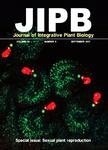Na^+ and Water Uptake in Relation to the Radial Reflection Coefficient of Root in Arrowleaf Saltbush Under Salt Stress
Na^+ and Water Uptake in Relation to the Radial Reflection Coefficient of Root in Arrowleaf Saltbush Under Salt Stress作者机构:College of Life Sciences Ludong University Yantai 264025 China
出 版 物:《Journal of Integrative Plant Biology》 (植物学报(英文版))
年 卷 期:2007年第49卷第9期
页 面:1334-1340页
核心收录:
学科分类:09[农学] 0903[农学-农业资源与环境]
基 金:the National Natural Science Foundation of China(30471044) the Shandong Provincial Bureau of Science and Technology(120101118)
主 题:anti-osmosis arrowleaf saltbush (Atriplex triangularis Willd) radial reflection coefficient of root salt stress xylem pressure
摘 要:The response of halophyte arrowleaf saltbush (Atriplex triangularis Willd) plants to a gradient of salt stress were investigated with hydroponically cultured seedlings. Under salt stress, both the Na^+ uptake into root xylem and negative pressures in xylem vessels increased with the elevation of salinity (up to 500 mol/m^3) in the root environment. However, the increment in negative pressures in root xylem far from matches the decrease in the osmotic potential of the root bathing solutions, even when the osmotic potential of xylem sap is taken into consideration. The total water potential of xylem sap in arrowleaf saltbush roots was close to the osmotic potential of root bathing solutions when the salt stress was low, but a progressively increased gap between the water potential of xylem sap and the osmotic potential of root bathing solutions was observed when the salinity in the root environment was enhanced. The maximum gap was 1.4 MPa at a salinity level of 500 mol/m^3 without apparent dehydration of the tested plants. This discrepancy could not be explained with the current theories in plant physiology. The radial reflection coefficient of root in arrowleaf saltbush decreased with the enhanced salt stress was and accompanied by an increase in the Na^+ uptake into xylem sap. However, the relative Na^+ in xylem exudates based on the corresponding NaCl concentration in the root bathing solutions showed a tendency of decrease. The results showed that the reduction in the radial reflection coefficient of roots in the arrowleaf saltbush did not lead to a mass influx of NaCl into xylem when the radial reflection coefficient of the root was considerably small; and that arrowleaf saltbush could use small xylem pressures to counterbalance the salt stresses, either with the uptake of large amounts of salt, or with the development of xylem pressures dangerously negative. This strategy could be one of the mechanisms behind the high resistance of arrowleaf saltbush plants to



